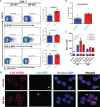Plasma EVs Display Antigen-Presenting Characteristics in Patients With Allergic Rhinitis and Promote Differentiation of Th2 Cells
- PMID: 34691024
- PMCID: PMC8531542
- DOI: 10.3389/fimmu.2021.710372
Plasma EVs Display Antigen-Presenting Characteristics in Patients With Allergic Rhinitis and Promote Differentiation of Th2 Cells
Abstract
Background: Allergic rhinitis (AR) is characterized by IgE-mediated mucosa response after exposure to allergens. Extracellular vesicles (EVs) are nano-size vesicles containing biological cargos for intercellular communications. However, the role of plasma EVs in pathogenesis of AR remains largely unknown.
Methods: Plasma EVs from patients with AR were isolated, quantified, and characterized. The expression of Der p 1 and antigen-presenting molecules on EVs was determined by Western blot, flow cytometry, or ELISA. PKH26- and CFSE (carboxyfluorescein succinimidyl ester)-stained AR-EVs were used to determine the uptake of EVs by CD4+T cells and their effects on CD4+T cell proliferation, respectively.
Results: Plasma EVs in healthy control (HC) and AR patients were similar in the concentration of particles, expression for specific EV markers, and both had structural lipid bilayer. However, the levels of Der p 1 on plasma EVs from both mild and moderate-severe AR patients were significantly higher than that on HC. The levels of antigen-presenting molecules on plasma EVs were similar from three subjects. Moreover, levels of Der p 1 on EVs in plasma, but not nasal secretion, were significantly associated with the symptom score of AR patients and level of plasma IL-13. Additionally, plasma EVs from patients with AR promoted the development of Th2 cells, while no effect was found on CD4+ T-cell proliferation.
Conclusions: Plasma EVs derived from patients with AR exhibited antigen-presenting characteristics and promoted differentiation of Th2 cells, thus providing novel understanding of the pathogenesis of AR.
Keywords: Der p 1; allergic rhinitis; antigen presentation; extracellular vesicles; type 2 T helper cells.
Copyright © 2021 Fang, Zhou, Peng, Liu, He, Chen, Chen and Fu.
Conflict of interest statement
The authors declare that the research was conducted in the absence of any commercial or financial relationships that could be construed as a potential conflict of interest.
Figures






Similar articles
-
Functions and Clinical Applications of Extracellular Vesicles in TH2 Cell-Mediated Airway Inflammatory Diseases: A Review.Int J Mol Sci. 2024 Aug 30;25(17):9455. doi: 10.3390/ijms25179455. Int J Mol Sci. 2024. PMID: 39273399 Free PMC article. Review.
-
Plasma extracellular vesicles regulate the Functions of Th2 and ILC2 cells via miRNA-150-5p in patients with allergic rhinitis.Int Immunopharmacol. 2025 Jan 10;144:113644. doi: 10.1016/j.intimp.2024.113644. Epub 2024 Nov 23. Int Immunopharmacol. 2025. PMID: 39580865
-
Derp1-modified dendritic cells attenuate allergic inflammation by regulating the development of T helper type1(Th1)/Th2 cells and regulatory T cells in a murine model of allergic rhinitis.Mol Immunol. 2017 Oct;90:172-181. doi: 10.1016/j.molimm.2017.07.015. Epub 2017 Aug 9. Mol Immunol. 2017. PMID: 28802126
-
Immunomodulatory effect of mesenchymal stem cells-derived extracellular vesicles to modulate the regulatory T cells and Th1/Th2 imbalance in peripheral blood mononuclear cells of patients with allergic rhinitis.Scand J Immunol. 2024 Dec;100(6):e13416. doi: 10.1111/sji.13416. Epub 2024 Oct 29. Scand J Immunol. 2024. PMID: 39473031
-
[Progress in dendritic cell-derived exosomes in allergic rhinitis].Xi Bao Yu Fen Zi Mian Yi Xue Za Zhi. 2024 May;40(5):460-464. Xi Bao Yu Fen Zi Mian Yi Xue Za Zhi. 2024. PMID: 38790103 Review. Chinese.
Cited by
-
Functions and Clinical Applications of Extracellular Vesicles in TH2 Cell-Mediated Airway Inflammatory Diseases: A Review.Int J Mol Sci. 2024 Aug 30;25(17):9455. doi: 10.3390/ijms25179455. Int J Mol Sci. 2024. PMID: 39273399 Free PMC article. Review.
-
The Role of Small Extracellular Vesicles and MicroRNAs in the Diagnosis and Treatment of Allergic Rhinitis and Nasal Polyps.Mediators Inflamm. 2022 Jun 16;2022:4428617. doi: 10.1155/2022/4428617. eCollection 2022. Mediators Inflamm. 2022. PMID: 35757106 Free PMC article. Review.
-
The Role of Extracellular Vesicles in Allergic Sensitization: A Systematic Review.Int J Mol Sci. 2024 Apr 19;25(8):4492. doi: 10.3390/ijms25084492. Int J Mol Sci. 2024. PMID: 38674077 Free PMC article.
-
The Role of Epithelial-Derived Extracellular Vesicles in Allergic Sensitisation: A Systematic Review.Int J Mol Sci. 2025 Jun 17;26(12):5791. doi: 10.3390/ijms26125791. Int J Mol Sci. 2025. PMID: 40565252 Free PMC article.
-
Tempol Alters Urinary Extracellular Vesicle Lipid Content and Release While Reducing Blood Pressure during the Development of Salt-Sensitive Hypertension.Biomolecules. 2021 Dec 1;11(12):1804. doi: 10.3390/biom11121804. Biomolecules. 2021. PMID: 34944449 Free PMC article.
References
-
- Bousquet J, Khaltaev N, Cruz AA, Denburg J, Fokkens WJ, Togias A, et al. . Allergic Rhinitis and its Impact on Asthma (ARIA) 2008 Update (in Collaboration With the World Health Organization, GA(2)LEN and AllerGen). Allergy (2008) 63(Suppl 86):8–160. doi: 10.1111/j.1398-9995.2007.01620.x - DOI - PubMed
Publication types
MeSH terms
Substances
LinkOut - more resources
Full Text Sources
Research Materials

